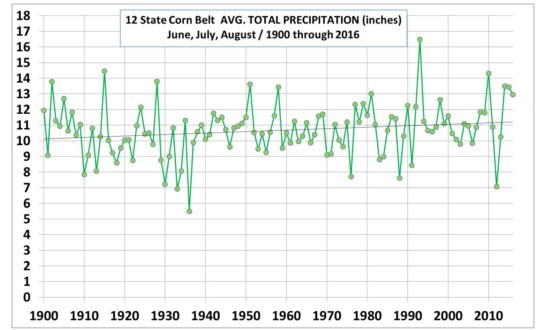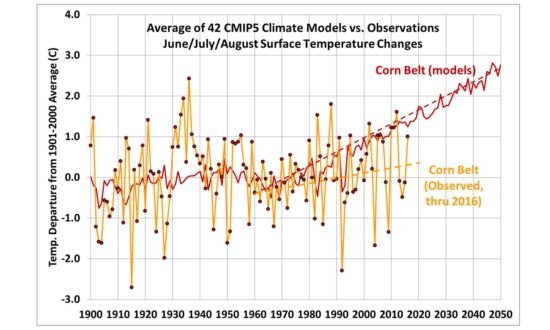‘Global Warming’ be Damned: Record Corn, Soybeans, Wheat
October 14th, 2016 by Roy W. Spencer, Ph. D.
For many years we have been warned that climate change is creating a “climate crisis”, with heat and drought reducing agricultural yields to the point that humanity will suffer. Every time there’s a drought, we are told that this is just one more example of human-caused climate change.
But droughts have always occurred. The question is: Are they getting worse? And, has modest warming had any effects on grain yields?
We have yet to experience anything like the Dust Bowl drought of the 1930s, or the mega-droughts the western U.S. tree ring record suggests occurred in centuries past.
And even if they do occur, how do we know they were not caused by the same natural factors that cause those previous droughts? While “global warming” must cause more precipitation overall (because there is more evaporation), whether this means increased drought conditions anywhere is pretty difficult to predict because it would require predicting an average change in weatherpatterns, which climate models so far have essentially no skill at.
So, here we are with yet another year (2016) experiencing either record or near-record yields in corn, soybeans, and wheat. Even La Nina, which was widely feared would cause reduced crop yields this year, did not materialize.
How can this be?
How has Climate Changed in the U.S. Corn Belt?
Let’s start with precipitation for the main growing months of June-July-August over the 12-state Corn Belt (IL, IN, IA, NE, ND, SD, MO, WI, MN, MI, MO, OH). All data come from official NOAA sources. Since 1900, if anything, there has been a slight long-term increase in growing season precipitation:
In fact, the last three years (2014-16) has seen the highest 3-yr average precip amount in the entire record.
If we examine temperature, there has been some warming in recent decades, but nothing like that predicted for the same region from the CMIP5 climate models:
That plot alone should tell you that something is wrong with the climate models. It’s not even obvious a statistically significant warming has occurred, let alone attribute it to a cause, given all of the adjustments (or lack of proper adjustments) that have been made to the surface thermometer data over the years. Note the models also cannot explain the Dust Bowl warmth of the 1930s, because the models do not
Cornell U: Developing countries may contribute more to climate change than advanced societies by 2030
While developed countries and regions have long been culprits for Earth’s rising greenhouse gas emissions, Cornell researchers – balancing the role of aerosols along with carbons in the equation – now predict a time when developing countries will contribute more to climate change than advanced societies: 2030.
Published in Environmental Research Letters (July 11), the new study was designed to inform international policymakers on the role of aerosols, as opposed to strictly greenhouse gases, when consideringclimate change mitigation.
“Historically, between 1850 and 2010, the United States and the European Union have contributed the most to Earth’s climate change. But the portion of global surface temperature change from human activities attributable to developing countries is increasing,” said Dan Ward, Cornell postdoctoral researcher and the study’s lead author. Natalie Mahowald, associate professor of earth and atmospheric sciences, is the senior author.
“In light of all factors, including our understanding of aerosols, we estimate that developing countries will surpass the contribution from developed countries around year 2030,” Ward said.…
Paper: ‘There’ll be nowhere to run from the new world government’
…
Flashback Oct. 2009 Climate Depot Oped: Climate Depot OPED: ‘Controlling climate? More like controlling humans’
…
UN IPCC Climate Chief Pachauri: Western Lifestyles are unsustainable — warns of ‘radical charges and regulation…iced water in restaurants should be curtailed’

…
‘Climate Rage’: ‘The only way to stop global warming is for rich nations to pay for the damage they’ve done – or face the consequences’
…


